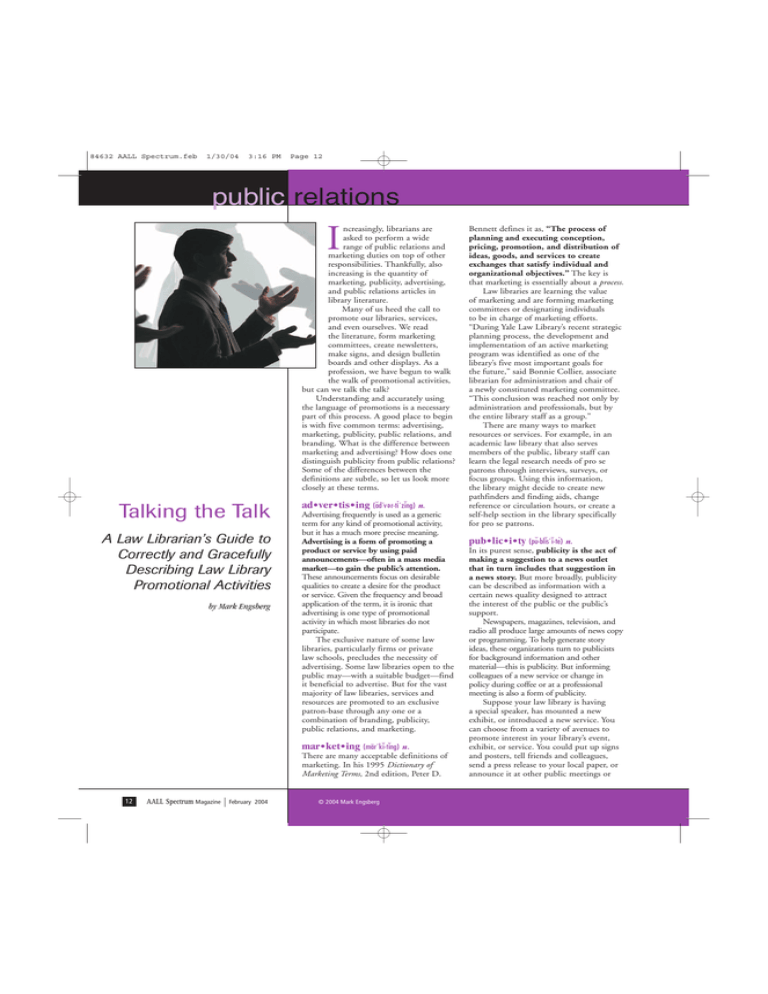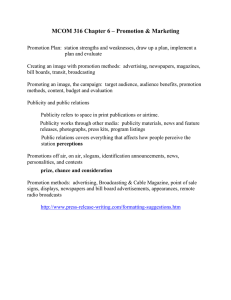public relations
advertisement

84632 AALL Spectrum.feb 1/30/04 3:16 PM Page 12 public relations I ncreasingly, librarians are asked to perform a wide range of public relations and marketing duties on top of other responsibilities. Thankfully, also increasing is the quantity of marketing, publicity, advertising, and public relations articles in library literature. Many of us heed the call to promote our libraries, services, and even ourselves. We read the literature, form marketing committees, create newsletters, make signs, and design bulletin boards and other displays. As a profession, we have begun to walk the walk of promotional activities, but can we talk the talk? Understanding and accurately using the language of promotions is a necessary part of this process. A good place to begin is with five common terms: advertising, marketing, publicity, public relations, and branding. What is the difference between marketing and advertising? How does one distinguish publicity from public relations? Some of the differences between the definitions are subtle, so let us look more closely at these terms. A Law Librarian’s Guide to Correctly and Gracefully Describing Law Library Promotional Activities by Mark Engsberg e Talking the Talk ad•ver•tis•ing (ăd´v r-ti ´z ĭng) n. Advertising frequently is used as a generic term for any kind of promotional activity, but it has a much more precise meaning. Advertising is a form of promoting a product or service by using paid announcements—often in a mass media market—to gain the public’s attention. These announcements focus on desirable qualities to create a desire for the product or service. Given the frequency and broad application of the term, it is ironic that advertising is one type of promotional activity in which most libraries do not participate. The exclusive nature of some law libraries, particularly firms or private law schools, precludes the necessity of advertising. Some law libraries open to the public may—with a suitable budget—find it beneficial to advertise. But for the vast majority of law libraries, services and resources are promoted to an exclusive patron-base through any one or a combination of branding, publicity, public relations, and marketing. mar•ket•ing (mär´kĭ-tĭng) n. There are many acceptable definitions of marketing. In his 1995 Dictionary of Marketing Terms, 2nd edition, Peter D. 12 AALL Spectrum Magazine February 2004 © 2004 Mark Engsberg Bennett defines it as, “The process of planning and executing conception, pricing, promotion, and distribution of ideas, goods, and services to create exchanges that satisfy individual and organizational objectives.” The key is that marketing is essentially about a process. Law libraries are learning the value of marketing and are forming marketing committees or designating individuals to be in charge of marketing efforts. “During Yale Law Library’s recent strategic planning process, the development and implementation of an active marketing program was identified as one of the library’s five most important goals for the future,” said Bonnie Collier, associate librarian for administration and chair of a newly constituted marketing committee. “This conclusion was reached not only by administration and professionals, but by the entire library staff as a group.” There are many ways to market resources or services. For example, in an academic law library that also serves members of the public, library staff can learn the legal research needs of pro se patrons through interviews, surveys, or focus groups. Using this information, the library might decide to create new pathfinders and finding aids, change reference or circulation hours, or create a self-help section in the library specifically for pro se patrons. pub•lic•i•ty (pŭ-blĭs´ĭ-te-) n. In its purest sense, publicity is the act of making a suggestion to a news outlet that in turn includes that suggestion in a news story. But more broadly, publicity can be described as information with a certain news quality designed to attract the interest of the public or the public’s support. Newspapers, magazines, television, and radio all produce large amounts of news copy or programming. To help generate story ideas, these organizations turn to publicists for background information and other material—this is publicity. But informing colleagues of a new service or change in policy during coffee or at a professional meeting is also a form of publicity. Suppose your law library is having a special speaker, has mounted a new exhibit, or introduced a new service. You can choose from a variety of avenues to promote interest in your library’s event, exhibit, or service. You could put up signs and posters, tell friends and colleagues, send a press release to your local paper, or announce it at other public meetings or 84632 AALL Spectrum.feb 1/30/04 3:16 PM community events. All of these activities generate publicity. Publicity can be informally and spontaneously generated by word of mouth, as well as carefully planned in a publicity or marketing department. Ken Kozlowski, director of the Supreme Court of Ohio Law Library, said that in his library, minor publicity efforts are generated in-house. Announcements at meetings and e-mail notices are used by library staff to inform colleagues and patrons of changes in library policies and services. But more substantive publicity efforts, Kozlowski said, such as changes in the design of new library cards, are coordinated with the court’s Public Information Office. He cites the impending move of his court library to new facilities in February 2004 as an event that will prompt increased publicity efforts requiring the services of the office. The library’s patrons and members of the public will need to be informed of the move, the library’s new location, and a host of related information. pub•lic- re•la•tions (pŭb´l ĭk r ĭ-la´sh ns) pl. n. e Public relations (PR) has existed as a distinct profession for about a century. Even so, it seems that few people outside PR academia can define what the profession is all about. Contrasted with publicity, PR is a much broader field, giving it a certain generic quality that often is misunderstood or misapplied. PR professionals claim that one should not compare PR to journalism, advertising, or marketing, arguing that these careers are sometimes confused because of underlying similarities and the changing dynamics of PR. Instead, they argue that the principal job of PR is to help organizations communicate effectively with their publics. Generally, PR encompasses publicity, but it also includes benefactor or donor relations, crisis communications, special events and sponsorships, and other activities that help shape the opinions of library patrons or the public at large. The earliest definitions of PR emphasized press agents and publicity, since these were key roles from which modern PR grew. Later as PR became more established, definitions began to include the roles of research, planning, and evaluation. These definitions tend to describe what PR does rather than what it is. In 1988, in an attempt to resolve this problem, the Public Relations Society of America (PRSA) adopted a definition of public relations that has become widely accepted and used: “Public relations helps an organization and its publics adapt mutually to each other.” Page 13 Like most organizations, law libraries interact with many publics: employees; law faculty or students; firm clients; members of the bench and bar; prospective clients; agencies within the legal profession; local, state, and federal governments; and the public at large. Depending on the circumstances of the library, PR efforts can range from expansive to fairly limited. Barbara Schmid, manager of library services at Baker & McKenzie in Chicago, explained that while her firm supports a dynamic, layered public relations program for the whole organization, the library takes a more limited approach to public relations. The Baker & McKenzie library reaches out to its principal public—its attorneys— through an in-house electronic newsletter, Bibliobytes, she said, and whenever possible, through direct contact with attorneys in their offices. brand•ing (brănd´ĭng) vt. A brand is a distinguishing name or symbol designed to assist patrons or customers in identifying the source of a good or service. Brands also serve to differentiate competing sets of goods or services. They can protect patrons or consumers from a competitor attempting to provide products or services that appear to be identical. While a brand is a thing, branding is a process, much like marketing. Branding occurs when one creates an association between a symbol, object, emotion, or perception and a product or service or even an entire library. The goal of branding is to show how your library stands apart from other information resources. At the same time, branding fosters attitudes of loyalty among your patrons and potential patrons. Library patrons are assailed with information about a variety of library resources, services, or products; often these resources meet the same need. Through branding, library patrons may be able to reduce their decision making to consider only the resources, services, or products that are relevant to individual patrons or that have met their needs acceptably in the past. Few law libraries appear to be engaged in efforts to establish brands of their own. Because active promotion of library resources is a relatively new activity for many law librarians, branding, if it occurs at all, is mostly a by-product of other promotional efforts. Also, most law libraries are components within larger organizations, such as courts, law schools, firms, or other types of corporations. In many cases, brands used within libraries are derived from umbrella organizations. Corporate or law firm logos and university or court insignias—examples of branding—frequently appear on their law libraries’ pathfinders, letterhead, Web pages, and other products. In nearly every case, these larger organizations closely regulate the use of brands associated with the parent organization, even when the brands are used by units within the organization itself—like law libraries. In Sum Advertising, marketing, publicity, and public relations, despite the norms of common parlance, should not be used as generic terms to describe any or all library promotional activities. Instead, they most correctly apply as terms useful for describing specific activities: advertising denotes paying for space or time in the hopes of connecting with an audience; marketing is a process involving a broad range of activities; publicity entails bringing information with a certain news quality to the attention of various publics; PR attempts to help organizations communicate effectively with their publics; and branding denotes a distinct name or symbol meant to help patrons or customers identify the source of a good or service. Having examined the subtle (and not so subtle) differences among five common terms used to describe promotional activities, law librarians should be able to correctly and gracefully talk the talk with colleagues—and hold their own with seasoned Madison Avenue-types. Mark Engsberg (mark.engsberg@ yale.edu) is the librarian for foreign and international law at Yale Law School’s Lillian Goldman Law Library in New Haven, Connecticut. ad index Advanced Productivity Software . . . . 30 Bernan . . . . . . . . . . . . inside back cover BNA, Inc.. . . . . . . . . . . . . . . . . . . . . . . 5 Cambridge University Press. . . . . . . . 23 Court Express . . . . . . . . . . . . . . . . . . 29 Global Securities Information, Inc. . . . . . . . . . . . . . . 9 LexisNexis™ . . . . . inside front cover, 3 Purdue University . . . . . . . . . . . . . . . 20 Royaltystat. . . . . . . . . . . . . . . . . . . . . 32 Social Law Library . . . . . . . . . . . . . . 31 Softlink . . . . . . . . . . . . . . . . . . . . . . . 22 West . . . . . . . . . . . . . . 7, 21, back cover AALL Spectrum Magazine February 2004 13




